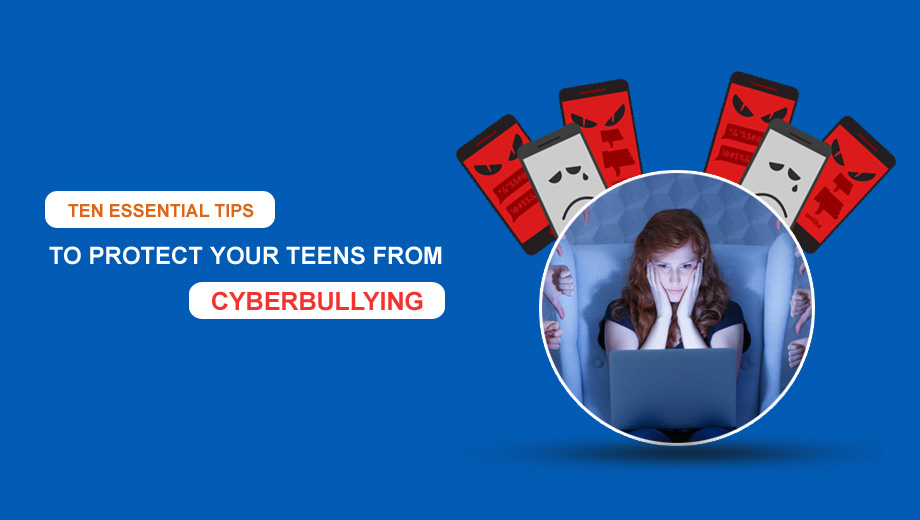Cyberbullying is nastier than traditional bullying. Statistics reveal cyber victims are twice more susceptible to self-harm and suicidal tendencies, especially those in teenage. The threat goes beyond harassment and misuse of digital devices. It is also a form of organised crime, and teens are the easiest targets.
The internet has become an essential part of our world. The pandemic has made it even more difficult to keep teens away from the internet menace. Teens are spending more time on the internet and are an easy target. The best way to stop is to prevent it. But it is impossible to stop it because you don’t know who will do it.
What is Cyberbullying?
It is also called cyber-harassment or online bullying. The culprits use digital technology to shame, anger or scare targeted people. The common platforms used are social media apps, messaging apps and online games. The four common forms are: –
- Publishing online information about an individual to humiliate, harass or defame the victim. It is also known as Doxing.
- Tracking or monitoring a person’s online activity to harass. It is also called Cyberstalking.
- Posting hurtful, threatening, or intimidating messages with an intent to harm a person. Known as Cyber harassment.
- Creating a fake account or gaining access to a person’s social media accounts to defame. It is also called Impersonation.
Five Facts about Cyberbullying
These are the five highlights that we all must know. This data is taken from cybercrime reports and studies conducted by various government and independent agencies.
- There has been a 70% increase in these cases during the COVID-19 pandemic.
- Only 10% of teenagers report the matter to parents or teachers.
- Teen cyber victims are at greater risk of self-harm and suicidal behaviour.
- Girls are more likely to be victims than boys.
- Social media platforms are places where more than 40% of cases of harassment take place.
A teenage victim becomes mentally, emotionally, and physically traumatized. It may also affect his academic performance and may lead to low self-confidence. Children must be encouraged to talk to parents, elders and teachers when feeling intimidated. One of the easiest ways is to block the person who is a bully. This can be easily done for social media accounts. Such matters can be easily reported on Facebook, Twitter and Instagram. A UNICEF team reviews these reports 24X7. You can reach UNICEF, or you can also visit Child Helpline International to gain access to your country.
How to Protect Your Teens from Cyberbullying
This kind of bullying doesn’t end up in school, unlike traditional bullying. It will leave a trail and can follow your children for years. Parents and teachers need to protect children, especially teenagers. The safety of children is a top priority issue for all parents. Here are some tips that will help protect your children.
Talk to your children
Teenage is the age of rebellion. Never close the channel of communication with your children. Ask your children about their day to day activity, what they have learnt and any issue bothering them. Encourage children to talk about their friends or relationship. Keep a track of their unknown online friends. Never stop talking to your children even if you are very angry with them. Without communication, you will never come to know what is happening in their life.
Set Screen Time and use Online Activity Apps
The best way to counter is by using technology. There are many apps available that can track children’s online activity. Some of these apps are The Spy Bubble, Norton family, and Secure teens. Parents must imbibe discipline in children to limit screen time. Inculcate this habit at an early age. Don’t forcefully explain to your children about the harmful effects of too much online activity.
Knowledge is Power
Make children aware of cybercrime and various ways how cyberbullying can take place. Discuss with them about privacy, online threats, and ways to counter them. Learn with them how to set up a privacy setting for social media accounts. Learn safe online practices and discuss them often. Never hesitate to learn from teenagers who are much more tech efficient than parents.
Keeping away Gadgets won’t Help
We often think that mobile phones and technology is the culprit. Taking away the mobile phone or removing internet access will not help. You cannot keep your children away from technology, rather inculcate the responsibility factor in them. Make them understand that technology can be useful as well as harmful. It is how you handle it.
Beware of Behaviour Changes
The first sign of trouble is a sudden behavioural change in your children. If your child is anxious, depressed or isolates himself, take it as an alert signal. Do not scroll through their Facebook posts or messages. Let the child talk for himself. Shame and exposure can make things worse for a child. You must tackle mental weakness and fear by positive psychology.
Act, don’t React
In 90% of the cases, parents don’t know how to act in difficult situations. Your reactions can make things worse. If your children confess to some online activity that is causing embarrassment to them, the first thing is to build their confidence. Let your child explain the situation and the reason for his worry. The next step is to review the matter. Sometimes petty issues are flared out of proportions. Children must know their parents will stand by them in every situation.
Protect Personal Information
Hacking is one of the main reasons. Hackers gain access to cyberspace and exploit teens. Educate your children about online spy games, online thefts and cybercrimes. Explain to your children why it is important to be safe from hackers.
Keep Evidence
Sometimes the bullying issue becomes complex. It may also need legal advice to bring culprits to justice. Save the messages and offensive comments. It will be required as proof in court or to lodge a police complaint.
Stand up for Others
If you don’t stand up for others, no one will stand up for you. Remember, a victim is not at fault. Give confidence to the victims and be unified to fight the menace.
What if Your Child is a Culprit?
This kind of situation is not only urgent, but it will also make you feel that you are not a good parent. 50% of the parents try to turn a blind eye towards reality and don’t accept their child is a bully. The first step is to find out why the child is doing this? Explain that this kind of behaviour is unacceptable. Talk about the consequences and punishments under the law. Share your concern and find out the legal implications. In these kinds of cases, you may also need professional help.
Do’s and Don’t for Parents to protect Teens from Cyberbullying
DO
- Do talk to your child every day before going to bed. Discuss their routines and what they have learnt today. Ask them about any issues or problems.
- Do limit their screen time. Your children will follow in your footsteps, limit your screen time as well.
- Do share cybercrime stories with your children and ask them about the lessons learnt.
- Do ask your child for solutions to your problems. It will help in winning their confidence.
- Do educate them about password privacy and protecting personal information online.
- Do stand up for others. Stay united for a cause.
DON’T
- Don’t lose your mind if things go wrong. Look for a solution and never blame the child.
- Don’t Flare up the issue if the offence is minor. Delete the messages and ignore petty issues.
- Don’t read your child’s messages or posts in front of him. Even if you read something objectionable, don’t react.
- Don’t let your child get attached to gadgets. Teach them the importance of relationships.
Final Word
The increased use of technology and social distancing has increased the stress level. Isolation has given a levy to teens who are spending more time online. It has not only increased their distraction level, but they are now more prone to cyber-attacks. As a parent, it is important to know the risk and provide a meaningful solution.

